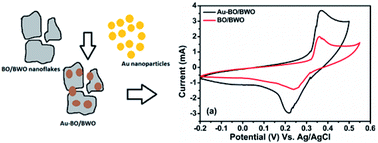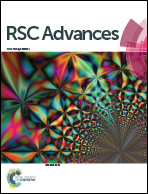Development of pristine and Au-decorated Bi2O3/Bi2WO6 nanocomposites for supercapacitor electrodes†
Abstract
Pristine and Au-decorated Bi2O3/Bi2WO6 nanocomposites were synthesized via a facile hydrothermal method. Characterization techniques such as XRD, FESEM, HRTEM and XPS were used to explore the structural, morphological and electronic properties. Furthermore, electrochemical characterizations including cyclic voltammetry (CV), the galvanostatic charge–discharge (GCD) method, and electrochemical impedance spectroscopy (EIS) were performed to investigate the supercapacitance behaviour of the synthesized materials. Interestingly, the Au-decorated Bi2O3/Bi2WO6 nanocomposite showed a higher capacitance of 495.05 F g−1 (1 M aqueous KOH electrolyte) with improved cycling stability (99.26%) over 2000 cycles, measured at a current density of 1 A g−1, when compared to the pristine Bi2O3/Bi2WO6 composite (capacitance of 148.81 F g−1 and good cycling stability (95.99%) over 2000 cycles at a current density of 1 A g−1). The results clearly reveal that the decoration of the Bi2O3/Bi2WO6 composite with Au nanoparticles enhances its supercapacitance behaviour, which can be attributed to an increase in electrical conductivity, good electrical contact between the electrode and electrolyte, and an increase in effective area. The Au-decorated Bi2O3/Bi2WO6 nanocomposite can be considered as an electrode material for supercapacitor application.



 Please wait while we load your content...
Please wait while we load your content...